Triflic Acid
Hazard to Others
  
Posts: 486
Registered: 27-9-2020
Member Is Offline
Mood: Slowly Oxidizing into Oblivion
|
|
Sulfur Iodine Methanol Reaction Failure.
Introduction
A while back, in this thread I theorized that sulfur iodine and methanol would react to form methyl iodide, similar to the way that red P, iodine and methanol
react to form methyl iodide. So, this Sunday, I got around to testing it.
Procedure
The apparatus seen below was set up. A 100mL round bottom flask, a long Liebig condenser, and a calcium chloride drying tube were placed on top of one
another. To the RBF, 40mL of technical grade methanol that was left over anhydrous calcium chloride for two days was added. To this, 12 grams of
homemade iodine were added. The iodine had been dried with concentrated sulfuric acid before this experiment. On top of this, 3.3 grams of lab grade
sulfur were added. This is a slight ~3% excess.
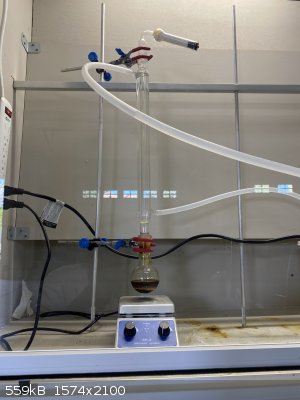
A stir bar was dropped in and the mixture was stirred to dissolve as much of the iodine as possible. The condenser was turned on with ice cold water,
which can be seen below.
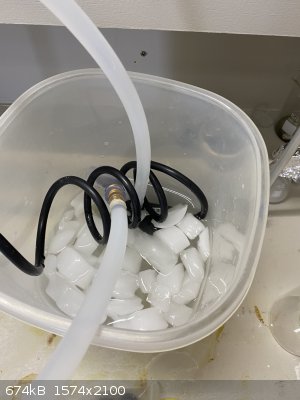
After this, it was placed in a hot water bath and gradually heated to 65C. One it reached that temperature, it was held there for one and a half
hours. I wanted to include a time lapse, but SM refuses to render it. There was no change that I could see over the course of the time-lapse anyways.
After an hour and a half, the hot water bath was removed and the flask was allowed to cool. The flask after cooling is seen below.
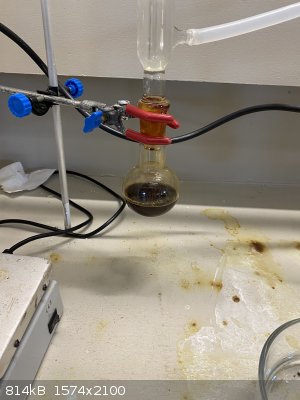
This left me with a thick sludge that, with much difficulty, I poured into a large beaker, which gave the sludge seen in the next image. To this, a
~100mL portion of water was added.
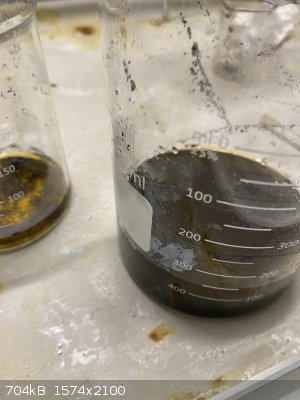
After the iodine and sulfur sludge had settled out, the liquid was transferred to a separatory funnel. The iodine and sulfur sludge was washed twice
with water to get out any remaining methyl iodide. Once these washing were transferred to the separatory funnel, I was left with the following after
waiting around 10 minutes to see if any phase separation occurred.
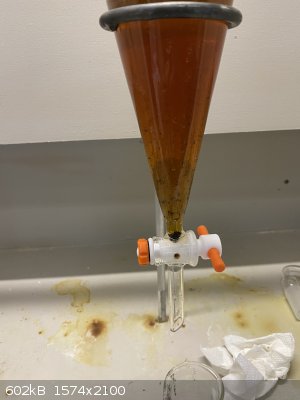
Since no phase separation occurred, there seems to be no methyl iodide in the mixture. However, just to be safe, this liquid was drained into a sodium
hydroxide solution to destroy any tiny amount methyl iodide that may have formed. Going back to the solid sludge, which looked like this:
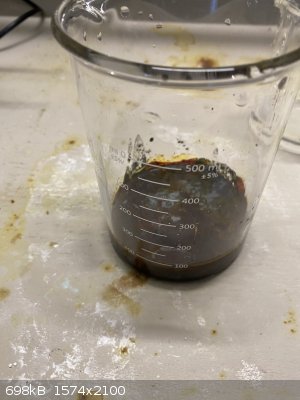
I washed this a few times and then left it on a vacuum frit to dry. In the end, I recovered most of the, if now slightly wet, iodide that I put in.
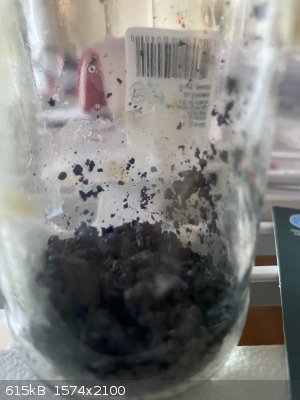
Discussion
Given that this was a failure, there isn't much to write here. The only issue that my have happened was that my methanol was dried over calcium
chloride instead of molecular sieves, and that introduced a calcium chloride impurity. However, I didn't have any other drying agents available to me.
There wasn't a fire, we just had an uncontrolled rapid oxidation event at the power plant.
|
|
|
clearly_not_atara
International Hazard
    
Posts: 2691
Registered: 3-11-2013
Member Is Offline
Mood: Big
|
|
https://drc.uc.edu/bitstream/handle/2374.UC/747827/The_Searc...
[Edited on 04-20-1969 by clearly_not_atara]
|
|
|
Jenks
Hazard to Others
  
Posts: 130
Registered: 1-12-2019
Member Is Offline
|
|
It seems that sulfur does not like to react with iodine. However, if the iodine were reduced to hydriodic acid (or an acid like HCl were added to an
iodide salt), that should produce the wanted methyl iodide.
|
|
|
njl
National Hazard
   
Posts: 609
Registered: 26-11-2019
Location: under the sycamore tree
Member Is Offline
Mood: ambivalent
|
|
| Quote: |
However, if the iodine were reduced to hydriodic acid
|
Hence this thread. Sulfur being the alternative reducing agent to phosphorus.
Reflux condenser?? I barely know her!
|
|
|
Jenks
Hazard to Others
  
Posts: 130
Registered: 1-12-2019
Member Is Offline
|
|
It isn't that simple, is it? PI3 would provide acyl iodides but I don't think HI would.
|
|
|
Triflic Acid
Hazard to Others
  
Posts: 486
Registered: 27-9-2020
Member Is Offline
Mood: Slowly Oxidizing into Oblivion
|
|
You just contradicted yourself. First you said that HI would work, then you said it wouldn't.
There wasn't a fire, we just had an uncontrolled rapid oxidation event at the power plant.
|
|
|
woelen
Super Administrator
        
Posts: 7976
Registered: 20-8-2005
Location: Netherlands
Member Is Offline
Mood: interested
|
|
It is simple, sulfur does not react with I2. The sulfur just sits there as an inert filler. You could as well have added only I2 to the methanol.
|
|
|
Triflic Acid
Hazard to Others
  
Posts: 486
Registered: 27-9-2020
Member Is Offline
Mood: Slowly Oxidizing into Oblivion
|
|
Woelen, I was testing the presence of the formation of a Sulphur iodide intermediate. Something that's very transient but exists long enough in
solution to react with methanol and form methyl iodide. Read that thread in the Introduction. Now we know that sulfur doesn't react with iodine to
form the intermediate, but there was no way of knowing that before the experiment.
There wasn't a fire, we just had an uncontrolled rapid oxidation event at the power plant.
|
|
|
Texium
Administrator
       
Posts: 4508
Registered: 11-1-2014
Location: Salt Lake City
Member Is Offline
Mood: PhD candidate!
|
|
Quote: Originally posted by Triflic Acid  | | Now we know that sulfur doesn't react with iodine to form the intermediate, but there was no way of knowing that before the experiment.
|
Sure there was: https://pubs.acs.org/doi/10.1021/ar00163a002
Not to mention, if you just look at the electronegativities of sulfur (2.58) and iodine (2.66) they are effectively equal, which means that there is
practically no thermodynamic motivation for the elements to react.
And I’m not trying to denigrate you for trying the experiment. It’s always good to try things yourself anyway, even if there’s a precedent for
it not working. You may learn something new that you wouldn’t get from reading a paper. But to say “there was no way of knowing” is false, since
it took me 2 minutes to find a paper that will tell you all about sulfur iodides and how they can’t be formed in the way that you’re attempting.
|
|
|
Jenks
Hazard to Others
  
Posts: 130
Registered: 1-12-2019
Member Is Offline
|
|
HI will convert methyl alcohol into methyl iodide, but it doesn't convert acetic acid into acetyl iodide, while phosphorous triiodide does both these
things. So phosphorous is not merely reducing the iodine. The difference is that acyl halides react immediately with water which would form if HI
reacted with a carboxylic acid.
I've been thinking about this equilibrium problem a lot. If the hydrolysis of an acid halide is reversible, then a sufficiently efficient drying agent
should allow conversion of acids to acid halides with HX.
But back on topic, I would have loved if sulfur could replace phosphorous in this reaction. It does seem to work for bromine, and I wonder if there is
a way to make that more convenient or less noxious. For example, if bromide could be oxidized to bromine without oxidizing the sulfur first, this
might avoid having to handle bromine. And although methyl bromide wasn't the desired product, it could be converted into the iodide with sodium
bromide in acetone. Again, though, HBR can make methyl bromide directly so there is no need to involve sulfur. Sulfur becomes necessary for making
acyl halides.
One thing I would like to try for making alkyl iodides is to distill the iodide from a mixture the alcohol, HCl and sodium iodide. The corresponding
bromide would normally be made by distilling it from the alcohol, sulfuric acid and sodium bromide. Sulfuric acid oxidizes HI, but HCl should be
compatible. And since iodide is a much better nucleophile than chloride, only the iodide should be produced, at least for primary alcohols.
[Edited on 21-4-2021 by Jenks]
|
|
|
Triflic Acid
Hazard to Others
  
Posts: 486
Registered: 27-9-2020
Member Is Offline
Mood: Slowly Oxidizing into Oblivion
|
|
Oh shoot, I read acyl iodide as alkyl iodide. Sorry for the misunderstanding
There wasn't a fire, we just had an uncontrolled rapid oxidation event at the power plant.
|
|
|
Amos
International Hazard
    
Posts: 1406
Registered: 25-3-2014
Location: Yes
Member Is Offline
Mood: No
|
|
Even if this reaction were to work, heating the contents of the flask to 65C for an hour would effectively boil all your methyl iodide up and away
through your condenser; it's very difficult to condense even with an efficient condenser and ice-salt water. Still, we appreciate you investigating.
The reaction does work with aluminum foil if you'd like to try that next.
[Edited on 4-21-2021 by Amos]
|
|
|
rockyit98
Hazard to Others
  
Posts: 283
Registered: 12-4-2019
Location: The Known Universe
Member Is Offline
Mood: no mood is a good mood
|
|
Al works , i think there is chemplayer video about that.
"A mind is a terrible thing to lose"-Meisner
|
|
|
Triflic Acid
Hazard to Others
  
Posts: 486
Registered: 27-9-2020
Member Is Offline
Mood: Slowly Oxidizing into Oblivion
|
|
I actually watched that video from chemplayer, but I didn't like the dismal yield. I also don't need methyl iodide just yet. I'm wanting to test an
experimental way to make white P, so if that works I'll have the luxury to to use phosphorus to make the methyl iodide. If I can make phosphorus, I
could make oxalyl chloride. But anyway, if I do need methyl iodide, I'll use the Al foil method, because at least we know that that works. And Jenks,
the reaction of HCl with I- to give HI is really unfavorable since HI is stronger. But hey, its worth a shot.
There wasn't a fire, we just had an uncontrolled rapid oxidation event at the power plant.
|
|
|
njl
National Hazard
   
Posts: 609
Registered: 26-11-2019
Location: under the sycamore tree
Member Is Offline
Mood: ambivalent
|
|
If you want HI from an iodide salt, best use phosphoric acid. Magpie (RIP) made an excellent prep for phosphoric acid from calcium phosphate and
sulfuric acid. CaSO4 precipitates leaving you with very nice phosphoric acid, quite dry and pure if you use clean reagents.
Reflux condenser?? I barely know her!
|
|
|
Triflic Acid
Hazard to Others
  
Posts: 486
Registered: 27-9-2020
Member Is Offline
Mood: Slowly Oxidizing into Oblivion
|
|
But HCl is cheaper+no prep, so if it could work with it would be even better.
There wasn't a fire, we just had an uncontrolled rapid oxidation event at the power plant.
|
|
|